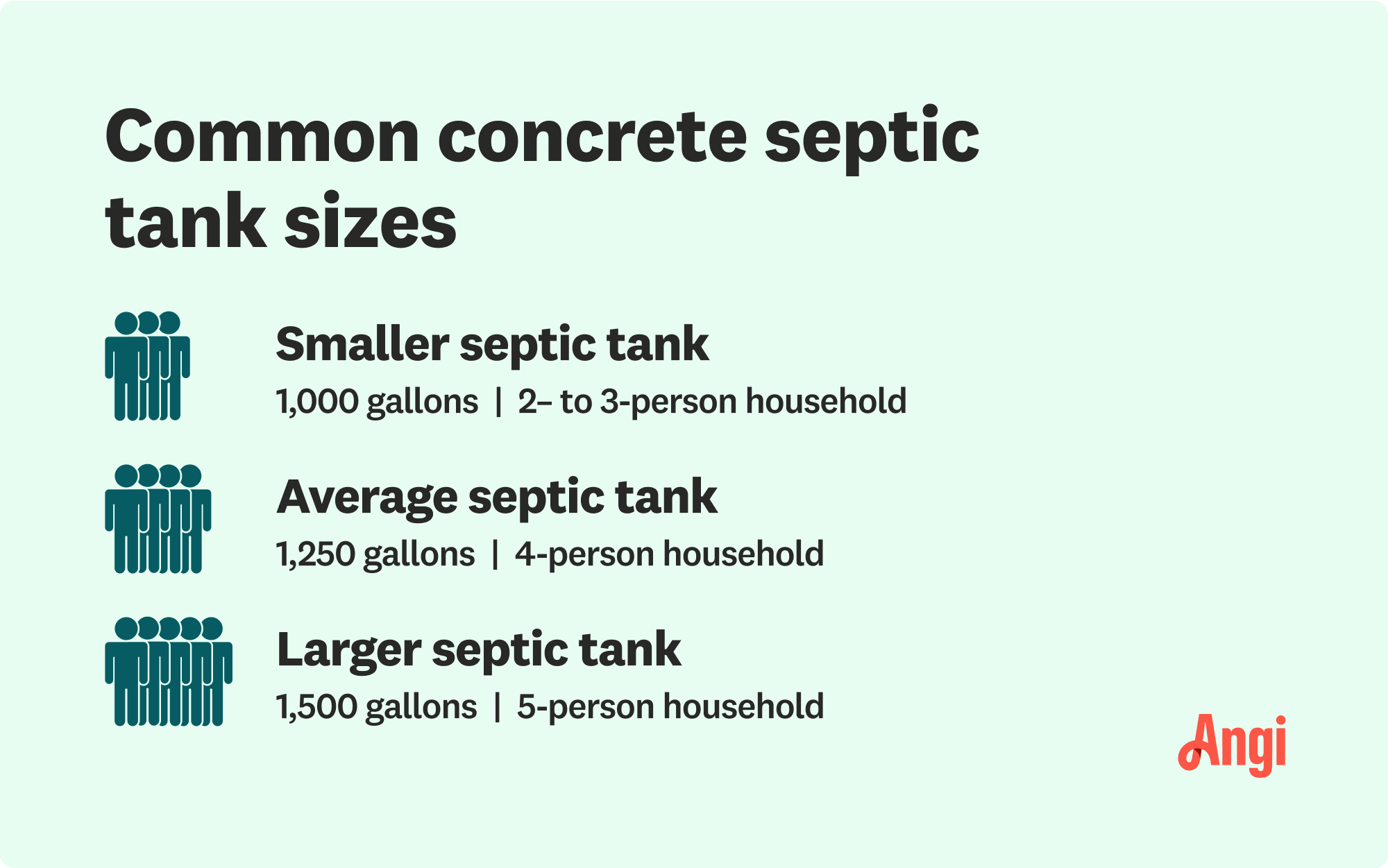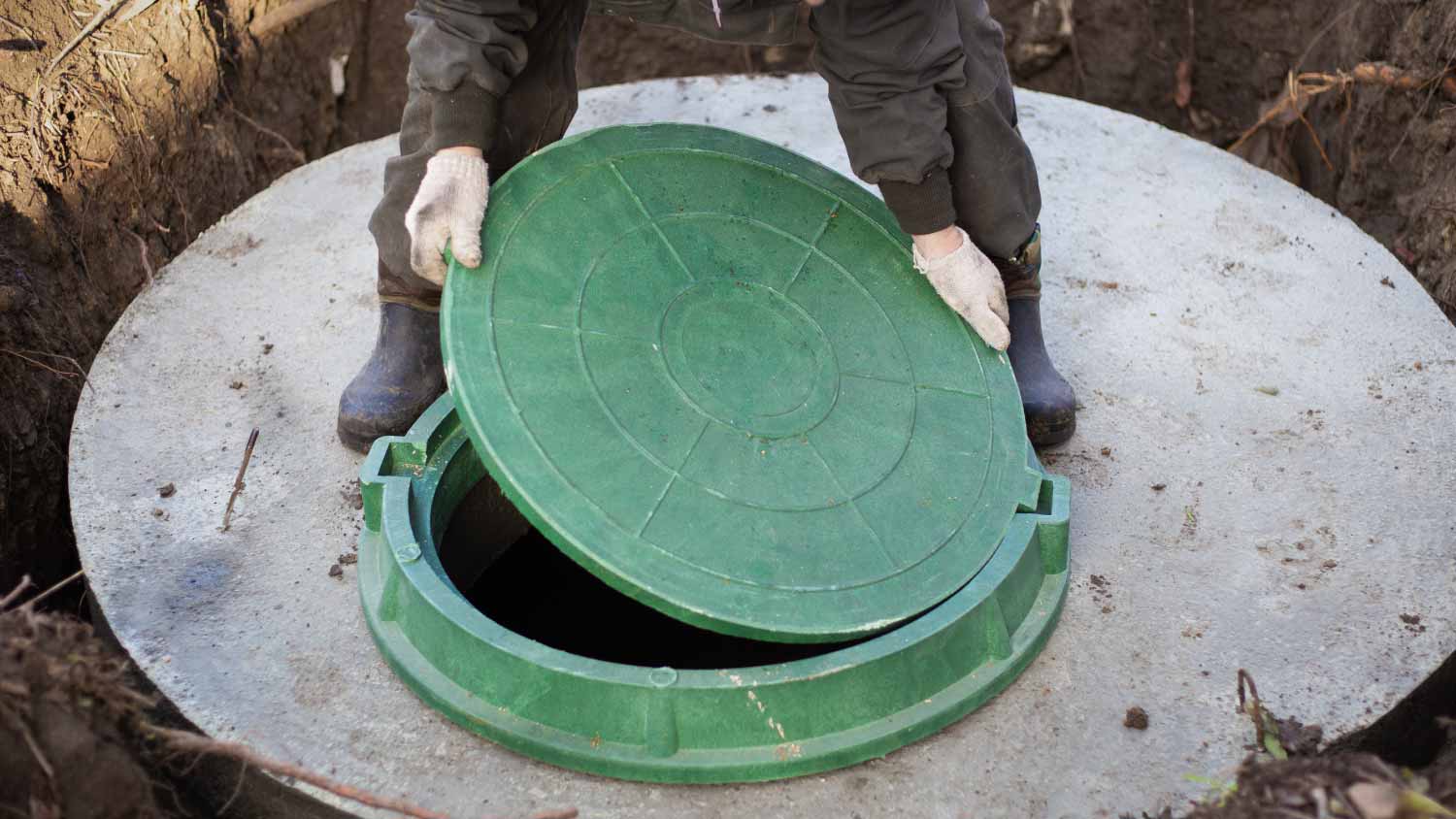
Does your property have poor ground water or soil conditions? Learn about engineered septic system cost, types, and factors for you to consider.
Make a solid size choice on your next septic tank


Concrete septic tanks vary in size, but the average size is 1,250 gallons.
Tanks often range from 1,000 to 1,500 gallons (or more).
The number of bedrooms in your house can help you determine the right septic tank size.
Your household size and water usage habits can also affect your ideal tank size.
On average, a new concrete septic tank costs $700 to $2,500.
Concrete is the most popular material for septic tanks, thanks to its durability and wide range of size options. But because there are so many concrete septic tank sizes available, it can be tricky to figure out which one will work best for your home. In short, it comes down to a few key factors, including how many people live in your home and how much water you use. Here’s how those variables impact septic tank sizes.

As you compare septic tank sizes, you’ll notice that they’re primarily provided in gallons (as well as feet and inches). The size in gallons represents a tank’s capacity—or how much wastewater it can handle in a day. Today, the standard concrete septic tank size is 1,250 gallons, with most ranging between 1,000 and 1,500 gallons. In terms of dimensions, the average septic tank measures 30 to 40 square feet.

As a rule of thumb, you can use the number of bedrooms in your home to calculate the minimum septic tank capacity for a house of that size. This method assumes that the more bathrooms you have, the more people live (and use water) in your home, increasing the minimum tank size you need. It’s not a perfect rule (after all, just one or two people can live in a five-bedroom home), but it’s a convenient starting point for calculating septic tank sizes.
It’s also important to note that many municipalities now require a minimum septic tank size of 1,000 gallons. So, even if you live alone in a small apartment where a 750-gallon tank would be sufficient, you still might have to buy one that’s 1,000 gallons or larger.
| Number of Bedrooms | Minimum Septic Tank Capacity in Gallons |
|---|---|
| 0 to 1 | 750 |
| 2 to 3 | 1,000 |
| 4 | 1,250 |
| 5 | 1,500 |
In a smaller space (for example, a studio apartment or one-bedroom condo) with one or two occupants, the minimum septic tank capacity is around 750 gallons. However, tanks of this size might not meet local government regulations, so a bigger tank might be necessary.
For slightly larger homes with two to three bedrooms, a 1,000-gallon septic tank is sufficient. Properties of this size may need a higher-capacity tank since they often have more occupants (such as family members, roommates, or guests) and, as a result, increased water usage.
Four-bedroom properties should have septic tanks with a minimum capacity of 1,250 gallons—the standard concrete septic tank size. A tank of this size should be able to accommodate the water consumption habits of a family with multiple children or a group of friends living together.
A fully occupied five-bedroom home needs a 1,500-gallon septic tank to process the amount of waste produced by a household of this size.
If you’re shopping for a new septic system, the sizes above will provide a general idea of the minimum septic tank capacity you’ll need. However, to get the most accurate estimate, it’s important to speak with a local septic tank company. Professional septic installers will help you choose the right size septic tank for your needs based on important factors like the size of your home, your water usage habits, and local regulations.

While the size of your house plays an important role in determining the right size septic tank, there are also other factors to consider.
As we’ve covered, septic pros often use the number of bedrooms in your home to come up with a quick estimate of your minimum septic tank capacity. It works on the assumption that more bedrooms equals more people, which means higher water consumption—and the more water you use, the higher your tank capacity should be.
Similarly, the number of people accessing your home’s water supply will affect your septic tank’s minimum capacity. In larger households, water consumption—from activities like showering, flushing toilets, washing dishes, and doing laundry—is higher than in smaller households. As a result, septic tanks in these homes must be larger to handle higher volumes of wastewater.
If you live alone or with one other person in a large house (say, four bedrooms or more), your water consumption should be far less than if every bedroom were full. Because of this, you might be tempted to buy a smaller septic tank to save money. However, this isn’t always a good idea. If you end up selling your home and the septic tank isn’t large enough to accommodate a full household, it could put off potential buyers.
Your water usage habits also impact how large your septic tank should be. You’ll want a tank that can hold at least two days’ worth of wastewater, which gives the solids enough time to settle and wastewater to keep moving through your septic system. For reference, the average American family uses 300 gallons of water each day, according to the Environmental Protection Agency.
When the weather is warm, the bacteria inside septic tanks break down waste faster than when it’s cold. As such, people in hotter climates (like Florida) might not need as large of a tank as those in chillier regions (like Maine).
Depending on where you live, there may be laws regarding the minimum size septic tank you can install on your property. To learn more about your local legislation, ask your septic pro.
When your septic tank is too small to keep up with your water usage, it can cause a number of problems, including sewage backups, leaks, and bad smells. If you’re in this position, you may be able to resolve the issue by reducing your water consumption or pumping your septic tank more frequently. Otherwise, you might need to replace your current tank with a higher-capacity one.
The cost of a new septic tank will depend on its size:
| Minimum Septic Tank Capacity in Gallons | Average Cost |
|---|---|
| 750 | $700–$1,200 |
| 1,000 | $900–$1,500 |
| 1,250 | $1,200–$1,600 |
| 1,500 | $1,500–$2,500 |
If your septic tank is too big for your property, it might not hold enough liquid for the bacteria to break down solid waste properly. Plus, since larger tanks are more expensive than smaller ones, buying an oversized one is an unnecessary use of your money.
In either case, whether you’re dealing with a septic tank that’s too small or too big, reach out to a septic pro to discuss your options.
From average costs to expert advice, get all the answers you need to get your job done.

Does your property have poor ground water or soil conditions? Learn about engineered septic system cost, types, and factors for you to consider.

Plumbing system having issues? Learn about sewer line camera inspection costs, the factors that impact it, and how to save on this crucial service.

If it’s been there for a while, it can be hard to find the septic tank in your yard. Learn how much it costs to locate a septic tank with this guide.

What is a septic tank distribution box, and how important is it? Learn about this critical component, its purpose, and how it functions in this guide.

There are different types of septic systems. The right one for you depends on its size and construction as well as your household waste needs.

Gurgling, slow drains could mean a main sewer line clog, which can be messy and smelly. Learn how to clear a main sewer line clog yourself with this guide.